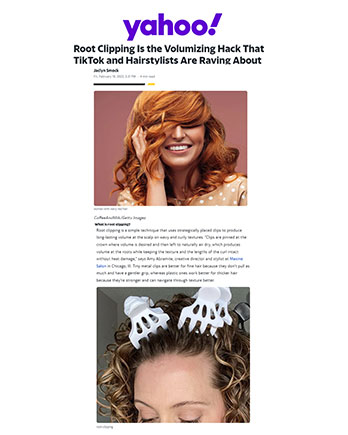Yahoo February 18, 2022
 Yahoo
Yahoo
News
Root Clipping Is the Volumizing Hack That TikTok and Hairstylists Are Raving About
Adding volume to your hair isn't exactly rocket science, but for a lot of us, it's also not as simple as it sounds. Enter TikTok, the app where hair experts and beauty lovers offer a fountain of knowledge, tips, tricks, hacks, and solutions to every issue —all condensed into easy-to-follow videos. The latest viral hack, root clipping, is smart, easy, and helps wavy and curly hair amplify volume without damaging the hair or overhauling current routines. Ahead, industry experts and leading celebrity hairstylists break down the trend and clear up any confusion, including what it is, how to start, and what hair types should skip it.
What is root clipping?
Root clipping is a simple technique that uses strategically placed clips to produce long-lasting volume at the scalp on wavy and curly textures. "Clips are pinned at the crown where volume is desired and then left to naturally air dry, which produces volume at the roots while keeping the texture and the lengths of the curl intact without heat damage," says Amy Abramite, creative director and stylist at Maxine Salon in Chicago, Ill. Tiny metal clips are better for fine hair because they don't pull as much and have a gentler grip, whereas plastic ones work better for thicker hair because they're stronger and can navigate through texture better.
Benefits of root clipping
According to Cédric, celebrity stylist and owner of Cédric Salon at Lotte New York Palace Hotel, root clipping is a safe and easy technique that helps achieve movement, lift, and volume to your roots that lasts much longer than a blowout. Think of this way: When the clips are placed into wet hair, the cuticle is malleable and open. As the hair dries, the cuticle closes, and the hair becomes less flexible so the hair holds the volumized shape until its wet again."
How to root clip
Before you start clipping, you should determine what kind of volume you need. "The eyes should be drawn to the center of the jawline to the fullness of the top of the style to create balance within the shape of the style. Square and pear face shapes need volume at the top to balance, while heart and diamond shapes need fullness at the sides to balance their face shape," explains Rodger Azadganian, founder of Ó“z Craft Luxury Haircare.
To begin, start with hair that is 70 percent dry. Take small sections of hair, choosing where you want the volume, place a clip in an upward motion, then close and secure it to the scalp, says Azadganian. Repeat as needed, and keep in mind that more rows of clips result in more volume. Follow with a spray of a volumizing product, let it dry, then remove the clips carefully so you don't disturb the ends and cause frizz or breakage.
Remember when selecting products to stay away from heavy creams and other products that'll weigh down the hair. Instead, opt for products that support your style by providing volume for your hair type and moisture to condition and tame texture, says Azadganian.
Which hair types should avoid root clipping?
Root clipping technically works on all hair types, but it works best on wavy/curly hair types 2B and up because these hair types can achieve volume at the roots through air-drying. It can also help these textures look bouncy instead of weighed down.
People with naturally straight hair should know that while they can try this technique to achieve volume, it might not produce the height they desire, and since there's no texture or bends in the hair, the clips can leave indents and cause static and frizz. Instead, "they should opt for a classic blowout to achieve volume and movement," says Erinn Courtney, StyleSeat hairstylist.
Should you try root clipping?
If your hair's texture is 2B and up, you should try root clipping to give it a lift because it's the easiest and least damaging technique to get volume at your roots without relying on a heated tool. That being said, straight hair should opt for blowouts for volume, and if you have naturally coarser hair that "stands up from your scalp naturally when dry, root clipping won't improve your volume and instead could deconstruct your natural texture," explains Courtney.
For those with sensitive or inflamed scalps, pause on trying this technique because the clips apply pressure to the roots and the scalp, which can cause further irritation or damage. To be sure if root clipping is right for your hair, consider chatting with your hairstylist or a trichologist, both of whom can tell you if it's safe for your hair and scalp and if it will give your hair type the desired volume.
